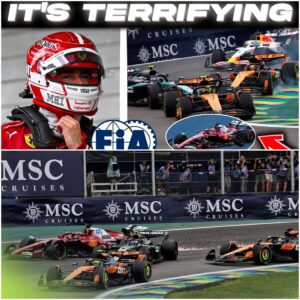The Brazilian Grand Prix was supposed to be a chapter in a gripping Formula 1 title race. Instead, it delivered a moment of visceral controversy that has not only widened the gap between championship contenders but has also ignited a fierce debate about the very nature of aggressive racing. At the heart of the storm is Oscar Piastri, the young McLaren prodigy whose season-long fight for the title took a devastating hit, punctuated by a 10-second time penalty that was as controversial as it was consequential.
The fallout from the ruling is more than just a matter of lost points; it is a dramatic turning point. It has shone a spotlight on Piastri’s uncompromising, high-stakes approach to the sport, an approach he staunchly defends even as it pushes him perilously close to the precipice of a title defeat and, worryingly, a race ban.

The Anatomy of the Lap Six Disaster
The incident occurred early in the race, immediately following a safety car restart. The tension was palpable, and opportunity was fleeting. Piastri, hungry to claw his way into a podium position, identified a gap into the fast, challenging Turn 1. He attempted an ambitious three-wide maneuver that required absolute precision and the willingness of his competitors to yield.
The young Australian thrust his car alongside Kimi Antonelli and Charles Leclerc, a move of breathtaking boldness. However, as the three cars converged, Piastri locked his front left tire. The inevitable contact followed: Piastri made firm contact with Antonelli, which sent the Mercedes driver veering into the side of the Ferrari driven by Leclerc. For the Scuderia star, the race was over—terminal damage forced him into immediate retirement.
The outcome was messy, costly, and demanded investigation. The stewards, after reviewing the footage and data, deemed Piastri “wholly responsible” for causing the collision. The punishment was harsh: a 10-second time penalty added to his race time, coupled with two penalty points on his Super License. This devastating decision instantly evaporated his potential podium finish, demoting him to a frustrating fifth place and allowing his championship rival and teammate, Lando Norris, to extend his lead to a daunting 24 points.
A Driver Unapologetic: “I Can’t Disappear”
The raw statistics of the result are crushing, but it is Piastri’s defiant post-race reaction that has truly captivated and polarized the F1 community. Far from offering a measured apology or suggesting he might reflect on his aggression, Piastri stood his ground, revealing a mindset that is simultaneously his greatest strength and a potential Achilles’ heel.
When pressed on whether he regretted the high-risk maneuver, his answer was instantaneous and unequivocal. “No, I don’t think so. I had a very clear opportunity, I went for it,” he stated. He argued that the cars on the outside, Antonelli and Leclerc, braked comparatively late, boxing him in. His lock-up, he insisted, was a reaction, not a cause, saying, “that was because I could see Kimi was not going to give me any space. I can’t disappear.”
This attitude—the belief that he saw a gap and was entitled to take it, regardless of the consequences—is the signature of a champion-in-the-making. The history of Formula 1 is littered with legendary overtakes born from this exact brand of boldness and fearless commitment. Yet, it is also a thin line, and the stewards firmly believed Piastri had crossed it, transforming brave ambition into careless recklessness.

The Rulebook Versus the Art of Racing
The official reasoning from the FIA stewards centered on a strict interpretation of the rulebook. Their statement highlighted that Piastri did not meet the “required overlap” on Antonelli to be entitled to the corner. According to the FIA driving standards guidelines, a driver’s front axle must be alongside the mirror of the car they are overtaking to establish ownership of the space. Piastri’s car fell short of this technical requirement. The fact that he locked up and was unable to avoid contact only sealed his fate.
However, this technical ruling has been met with significant resistance from former F1 drivers and industry veterans, deepening the controversy. Martin Brundle, the revered Sky Sports commentator and former F1 driver, emphatically declared that if he were presented with the same opportunity 20 times, he would take it every single time. He viewed it as a legitimate, hard racing move.
Similarly, former driver Jolyon Palmer questioned whether the penalty was fundamentally flawed, suggesting it was “judged on the outcome rather than the move itself.” The disastrous result—Leclerc’s immediate retirement—likely weighed heavily on the stewards’ minds. In a stunning display of solidarity and sportsmanship, even Charles Leclerc, the victim who lost his entire race, defended Piastri, stating he did not believe the penalty was deserved.
This profound disagreement highlights one of modern Formula 1’s enduring challenges: the attempt to apply cold, consistent rules to the dynamic, heated art of racing. Every corner, every safety car restart, and every contact is unique. What constitutes a fair, aggressive maneuver to one observer can appear as dangerous driving to another. Piastri’s penalty has become the latest lightning rod for this decades-old philosophical conflict within the sport.
The Title Fight Hangs by a Thread
Beyond the debate over fairness, the most brutal impact of the penalty is on the 2025 championship battle. Piastri arrived in Brazil with realistic hopes of tightening the screws on his teammate, Lando Norris. He leaves with his title challenge severely weakened. Norris, who drove a brilliant race to victory, now enjoys a 24-point advantage, a significant cushion with only three races remaining.
While mathematically the title is still possible, the reality is that Piastri’s margin for error is now zero. He needs a perfect sequence of events: race wins, combined with significant misfortune or poor performance from Norris. Piastri acknowledged this brutal reality with a newly measured tone after discussing the incident itself. He stressed the need to focus on performance and “try and have the best weekends we can” in the final push. His realization is clear: dwelling on the past will not change the points deficit; only faultless execution in the races ahead can.
This situation also creates a serious internal dilemma for McLaren. With two drivers fighting for the top prize, the team has maintained a public stance of allowing them to race freely. However, with Norris now holding a commanding lead, the question of team orders looms larger than ever. If Piastri finds himself fighting Norris for a crucial position in Las Vegas or Qatar, will the team finally step in to protect their leading driver and ensure the championship comes home? The answer to this difficult question will define McLaren’s sporting integrity in the coming weeks.

The Ticking Time Bomb of Penalty Points
Adding a crippling layer of pressure to Piastri’s already difficult situation is the matter of his Super License penalty points. The two points he received in Brazil were not just a symbolic slap on the wrist; they pushed his total to a concerning eight penalty points over the rolling 12-month period.
The FIA threshold is 12 points, which results in an automatic, mandatory one-race ban. This means Piastri now has a ticking time bomb hanging over his head. He cannot afford to incur four more penalty points—the equivalent of two or three minor racing incidents—over the final three races.
This threat forces Piastri into an impossible balancing act. To close the 24-point gap, he must race aggressively, taking risks, sticking his car into gaps, and seizing every opportunity. Yet, he must simultaneously be hyper-aware of the slightest misjudgment that could lead to further penalties, which would immediately end his title challenge by sidelining him for an entire race. The very aggression that has defined his career and made him a champion-in-the-making is now a serious liability.
The Brazilian Grand Prix will be forever etched in the annals of the 2025 season as a pivotal moment. Before the race, Piastri was a true contender; after the race, he is fighting a desperate rear-guard action. His defiance is admirable, a promise that he will not change his style for fear of penalty. The championship now rests on whether that fierce, unyielding aggression can be channeled into clean, fast racing in the high-stakes environment of Las Vegas, Qatar, and Abu Dhabi. The title, a dream so close for so long, may ultimately hinge on a fraction of an inch, a split-second lock-up, and the philosophical conflict between the rulebook and the unadulterated passion of Formula 1.





